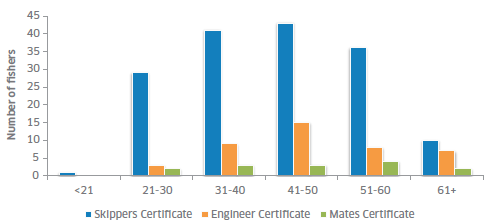Scottish Sea Fisheries Employment 2015
Second Scottish Sea Fisheries report providing information on the structure of employment and key characteristics of Scotland's sea fishing fleet.
Qualifications
The survey sought to gauge the level of qualifications of crew working in the Scottish fleet. It identified six groups of qualifications, which are:
- Basic safety training ( BST): also known as the certificate of competence which consists of four courses: 1) Sea Survival; 2) Fire Fighting and Prevention; 3) First Aid, and; 4) Health and Safety. BST is a minimum requirement for all crew working on a UK fishing vessel.
- Skipper certificates: qualifications required to skipper small commercial fishing vessels in inshore waters, which are: 1) Skippers <16.5m vessel up to 20nm, and; 2) Skipper <16.5m vessel up to 200nm. Qualifications to skipper large commercial fishing vessels are: 3) Skipper Class 2 - >16.5m vessels up to 150nm and; 4) Skipper Class 1 or full ticket - >16.5m unlimited.
- Engineer certificates: engineers have two grades - Class 1 and Class 2. Class 1 are chief engineers and required on vessels >30m in length and/or with engine power >750kw. Class 2 engineers are required on vessels >16.5m in length and as a second engineers on all vessels with engine power >750kw. An engineer is required on vessels >16.5m in length and a minimum of two engineers are required on vessels >30m.
- Mates certificates: two qualifications for seafarers in the Merchant Navy known as Mate Class 1 (master) and Mate Class 2 (chief). Transferable qualifications between merchant and fishing vessels.
- Other fishing certificates: certifications such as bridge watchkeeping, engineer room watchkeeping and radio operators certificates.
- Other marine sector qualifications: such as commercial diving, yacht masters and other offshore and merchant navy certificates not included elsewhere.
- Almost all of the crew in the 2015 survey (99.6%) gave information about their qualifications that are relevant for work in the fishing industry. This is compared to only 50% in the 2013 survey. In 2015, 32% of crews sampled had at least one certification higher than the mandatory Basic Safety Training ( BST) (Figure 18). The main certifications above BST are skipper (23%), engineer (6%) and mate qualifications (2%). The remaining 1% is 'other fishing' and 'other' qualifications.

Figure 18: Proportion of qualifications/certifications by type in the Scottish fishing industry among crew from sampled vessels (n = 750)

Figure 19: Proportion of qualifications above BST by nationality (n = 241)
Broken down by Scottish, rUK, EEA and non- EEA crews, over 96% of the qualifications discussed belonged to UK fishers ( Figure 19), due to the proportion of skippers certifications and skipper positions being held by Scottish/ rUK fishers. A high proportion (99%) of those who do not hold qualifications above the minimum BST are non- EEA nationals and at a slightly lower percentage (92%) for crew from the EEA . All EEA and non- EEA crews are required to take UK based training to work on a UK registered vessel and therefore may not have reported on other qualifications recognised overseas.

Figure 20: Proportion of different types of qualifications held for key roles (n = 232)
There are four different skippers qualifications and one group who did not specify their certificates. This latter group made up the highest proportion, followed by skippers holding Class 1 and <16.5m qualifications ( Figure 20). Of the two engineering qualifications, 81% held a Class 2 certificate and the remaining 19% held a Class 1. For mate qualifications, 75% of crews held a Class 1 certificate and the remaining 25% held a Class 2 certificate ( Figure 20).

Figure 21: Age profile of crew holding Skipper, Engineer and Mate/deckhand certifications (n = 216)
Skippers qualifications are present in all age groups, whilst engineering and mates certificates were absent from the <21 age group. A normal distribution for both skipper and engineer is illustrated in Figure 21.
Contact
There is a problem
Thanks for your feedback